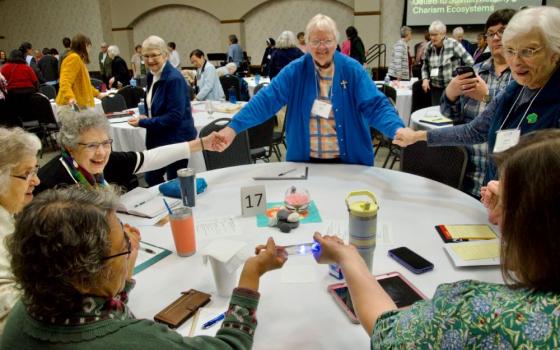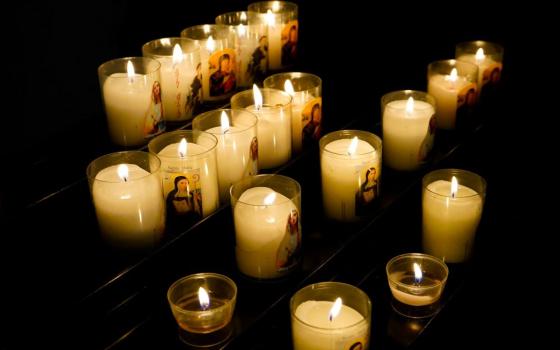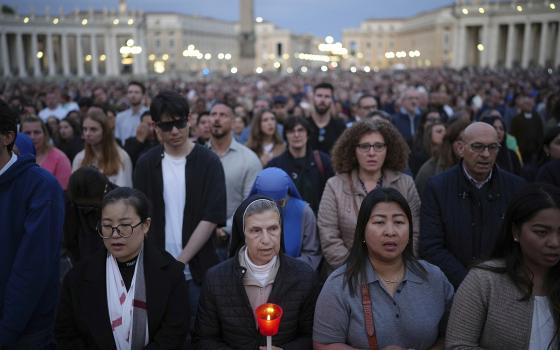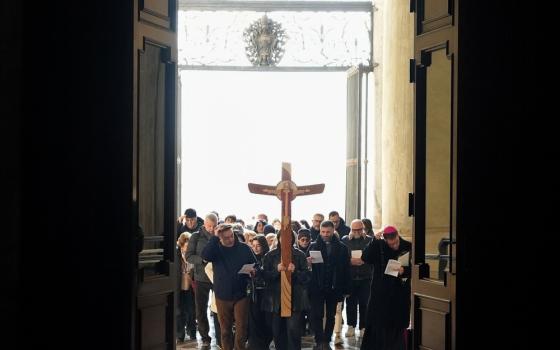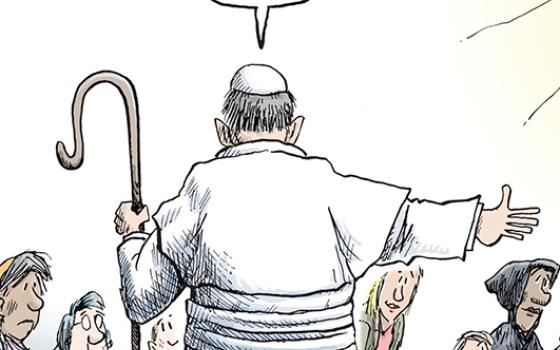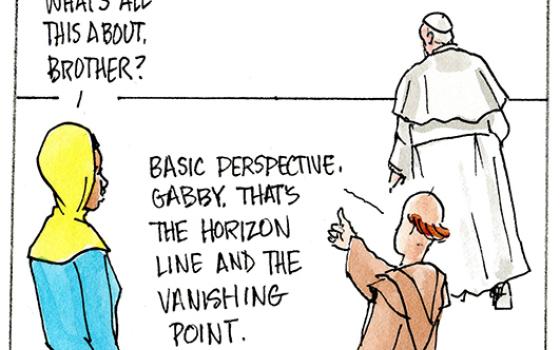
NCR video of Oct. 3 protest and police confrontation
As the leaves begin to change color and fall to the ground — sometimes when they are ready and other times prematurely by a blustery wind — I'm given to reflect on the mystery of letting go, so that new life can emerge.
This desire has deepened in me this year. It is harder and harder not to react to the multiple assaults on my mind and heart as the impeachment inquiry intensifies; as Mr. Trump's defenses bristle and deepen; and as electoral politics anticipate the homestretch to the first primaries … to name a few.
Like nature, I, too, need to find a way to survive the winter. I, too, need to "let go" so as to renew and imagine life reawakening come spring. Like nature, it isn't a cop-out. Rather, it is a way of nurturing one's own life; of not becoming the very thing that you rage against.
Centering prayer offers us a way to continue our intention of letting God be God within us throughout the day and when our emotions get the best of us. It is called the "Welcoming Prayer." Mary Mrozowski, a close friend and colleague of Trappist Fr. Thomas Keating, is attributed with developing this practice.
It complements the surrender practice of centering prayer in which we "let go" of thoughts, images, ideas. All contemplative practices invite us to drop down into the spaciousness of God's presence and over time discover our authentic self, our true self, our self in God.
However, when the times of sitting are over, there are almost 23 hours left to our day. The Welcoming Prayer helps us to cultivate ways of responding to the frustrations of our day from that same deep place.
The interesting thing about this practice is that it is not just letting go of a thought; rather it is embracing the emotion and the energy that has been building up prior to feeling frustration or anger or grief.
The practice redirects this energy "through the body so that it is liberated from the "false self" system and recaptured as vital energy for inner transformation" as Cynthia Bourgeault describes it in her book, Centering Prayer and Inner Awakening.
There are three basic movements:
- Focus, feel and sink into;
- Welcome;
- Let go.
First, we focus, feel and sink into what we are feeling. It is important to remember that our body stores all our unresolved emotional material of our lives. These unconscious emotional programs get set off by a myriad of things and cloud over the spaciousness we cultivate during our contemplative sitting. By becoming conscious of them we begin to dismantle them and free ourselves to return to our center, our true self.
We begin by scanning our body, becoming aware of any discomfort, uneasiness, feelings of hot or cold…any sensation. Simply be present to them.
In practicing this, after feeling quite upset and disgusted by what is happening politically, I scanned my body and found a tightness in my throat and upper chest. Once recognized, I simply stayed with it. No judgment.
Now, step two. Welcome it. Name the emotion and simply say, "welcome." As I stayed with the tightness, I found myself naming it "grief." I began to welcome grief.
This practice is quite paradoxical. It is rooted in the belief that by facing into or embracing the very thing we've been fighting, we disarm it.
What is important is that when we welcome that which we are experiencing, we are not welcoming or condoning or justifying a situation. We are welcoming the physical or psychological content of this moment only.
As I welcomed grief, I did not welcome those situations which prompted me to react in such ways that I experienced this feeling. I simply welcomed the feeling that my body held and which I named grief.
This is extremely important. To welcome and then let go of these emotional programs is not to "passively acquiesce to situations that are in fact intolerable," as Bourgeault writes in her book. As we continue the contemplative journey, we become more attuned to our center through which Divine Love flows through us. When we can respond from that center, then we can decide what action we must take in the outer world. Otherwise when we react without conscious awareness, we are reacting from our egoic self.
Finally, let go. This doesn't happen quickly. After repeating "welcome grief" and being aware of what is happening in my body, I eventually knew when it was time to let go. I simply said, "I let go of my grief."
Advertisement
Because the Welcoming Prayer is a practice this letting go is not final. We will feel such things again but as we practice these three steps, we are dismantling the emotional programs that keep us operating out of our egoic self and moving us off center where Divine Energy flows.
During these autumn days let us ponder the leaves falling and the trees welcoming their time of transformation and practice the Welcoming Prayer. Continue opening ourselves to our center where Divine Love and Energy flow. Face into the feelings that the injustices of our time generate in us so that they no longer bind up our energy which keeps us reacting in ways that only exacerbate the situations. Let us enter into our time of transformation. Like the trees, await the new life within us to emerge.
[Nancy Sylvester, IHM, is founder and director of the Institute for Communal Contemplation and Dialogue. She served in leadership of her own religious community, the Sister Servants of the Immaculate Heart of Mary, Monroe, Michigan, as well as in the presidency of the Leadership Conference of Women Religious. Prior to that she was National Coordinator of Network, the national Catholic social justice lobby. You may be interested in the current ICCD program, Enter the Chaos: Engage the Differences to Make a Difference. For information go to www.iccdinstitute.org]


